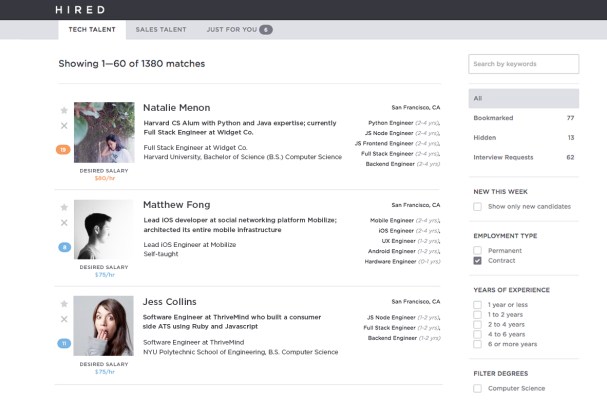Hired, a jobs marketplace for “knowledge workers,” thinks it has struck on a new way to grow its business: by adding freelancers to it roster.
It’s “not a big shift from our mission,” says Mehul Patel, who was promoted from president to CEO of the 157-person company in September, while previous CEO Matt Mickiewicz became chief product officer.
“Our mission is to get every one a job that they love, and we realized that a third” of the people who Hired tries to match with companies – including engineers, data scientists, product managers, user experience designers, and salespeople – “want to freelance,” he says.
The company’s observations follow broader trends. According to a recent study, 34 percent of U.S. workers are doing at least some freelancing, and 60 percent of those who’ve left traditional employment say they’re earn more freelancing.
Indeed, Hired, which has been beta testing its new features for freelancers for the last five months, says the average hourly rate for those hired through its platform is $85 an hour. Assuming those freelancers work roughly 40 hours a week, that’s a yearly salary of $177,000, which is nearly 30 percent more than the average annual salary for mid-range engineers on its platform.
That isn’t factoring in any vacation time, vacation pay, retirement or health benefits, but someone interested in flexibility might think that’s a decent trade-off.
The initiative also marks a new way for Hired to bring in revenue, which must be music to the ears of its investors, who’ve so far invested $32.7 million across three rounds in the company.
The service is theoretically free to users, but Hired tacks on 15 percent to the desired hourly salary of those clients, so if someone wants to be paid $100 an hour, Hired will charge the hiring company $115 an hour to cover the ongoing services it provides, including around payroll, taxes and other compliance issues. If Hired has to act as the employer of record and classify the person as a W2 worker, which it says happens in a minority of cases, then the fee is 30 percent.
The practice isn’t too far afield from how Hired’s full-time business works, where employers can pay 15 percent of a hire’s first year base salary or pay 1 percent per month for the employee’s first 24 months. (Hired also offers employers a subscription plan with a monthly flat fee for unlimited hires.)
In both scenarios, Patel says one of Hired’s biggest differentiators are the so-called talent advocates — full-time employees of Hired that the company matches with job-seekers, helping them polish their profiles, advising them on how to approach the interview process, and coaching them through compensation discussions.
Naturally, one might wonder if Hired’s decision to add contractors to its platform is a precursor to a new round. Patel says the company is indeed talking with investors again, saying Hired is “well-capitalized” but receiving “interest.”
He throws out some numbers to explain why, too. According to Patel, more than 3,000 companies are now using Hired to find help, it helps a job candidate land a job “every three hours,” its revenue has been tripling year over year, and it expects to reach a $100 million annualized run rate next year.
